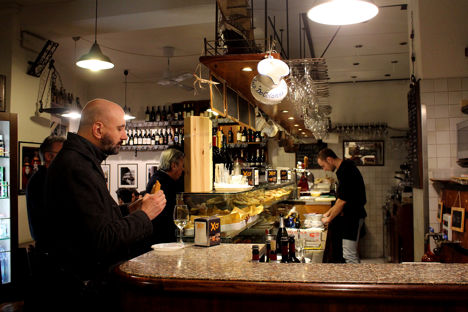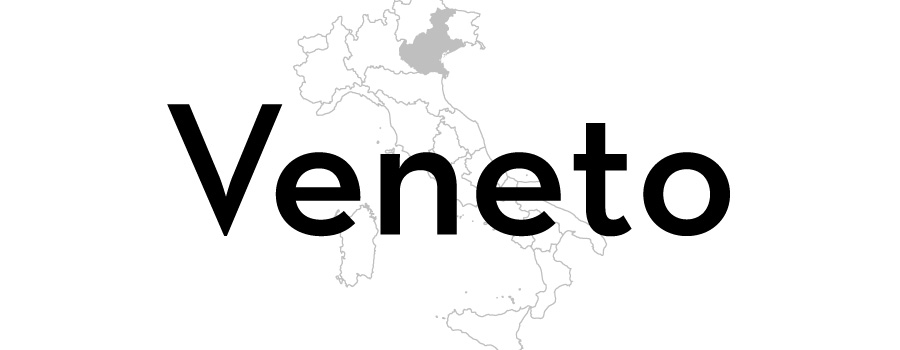
A guide to Venetian cichéti
Luca Marchiori takes us through the hidden side streets of Venice and talks us through the city's famous tapas-style dishes.
A guide to Venetian cichéti
Luca Marchiori takes us through the hidden side streets of Venice and talks us through the city's famous tapas-style dishes.
Let me teach you a few words of Venetian. We’ll start with bacaro. A bacaro is a bar, often small, sometimes medium and never large, the name deriving from that of Bacchus, the Roman god of wine. Real bacari are found tucked up side alleys, and can be spotted from a distance because of the clutch of people, like fish caught in a net, standing outside with small glasses in hand.
The contents of those glasses is our second word, ombra. An ombra is a drink, traditionally a glass of local wine, but now often a shockingly orange Aperol spritz. It’s a small drink and its name means ‘shade’. Some say this is because wine was once sold in the shadow of the majestic campanile in St Mark’s Square, but anyone who has experienced Venice’s searing August heat will understand how ‘let’s get some shade’ came to mean ‘let’s dodge up a side street into a bacaro for a quick drink’.
If you do dodge past the crowd into a bacaro, you’ll notice that the counter is made of glass and stuffed with dishes of food; sometimes elegant crostini, more often abundant fish or meat in sauces, served on small plates as a snack. Cichéti (the Venetian spelling for the more commonly used word cicchetti or cichetti) is the name for these small-plate snacks, and our third Venetian word.
It’s easy to see how, in a small city where space is at a premium, cichéti became a popular way to eat. You can meet your friends at a bacaro, start off with a small plate of something delicious, then when it gets too crowded, go for a quick stroll over Venice’s fairytale bridges to the next bacaro and the next plate of food. You can have a whole meal made up of all sorts of dishes, without being forced into a pattern of starters and main courses. You can eat as much, or as little, as you like. It’s a very democratic way of dining, highly appropriate for a city once the centre of one of Europe’s first republics.
The world of bacari, ombre, and cichéti is the real Venice; the mythical ‘Venice that the tourist never sees’. You find them all over the city, sometimes hidden under a sotoportègo – one of Venice’s typical passageways that take alleys right under buildings – near St Mark’s Square, but also in the peripheral districts of Dorsoduro, Castello, and Cannaregio. It often seems to me that tourist Venice and the real Venice exist as parallel realities, rather like the magical world of Harry Potter and the muggles. The real life of the city exists in its maze of back alleys, or calli, tucked just out of view behind the main sights.
Last Saturday night, I went on a ‘bacaro crawl’ with one of my Venetian friends, in the district of Cannaregio. We visited three different bars, the first one a very traditional bacaro popular with young Venetians, the second a bit more modern, and the third a bit more upmarket. This is what we ate.
The dishes
For our first plate, we went for the fish and had three classics: deep fried sardines in breadcrumbs; moscardini (baby octopuses) which are known as folpi in Venetian and sarde in soar, which consists of sardines marinated in a sweet and sour sauce with sultanas and pine nuts. It is considered to be one of the great classics of Venetian cuisine and has a fresh, light flavour, at odds with the fact that it was once used as a method of preserving fish.
On the advice of the barman, we ate these with an ombra of Tokay wine from Friuli, today a separate region of Italy but once part of the Venetian mainland territory. It was slightly sweet which made it the perfect accompaniment to the fish.
After a brief stroll through the moonlit alleys of Cannaregio, we arrived at the second bacaro and this time decided to sample polpette – meat or fish balls. We went for deep fried sea bass in breadcrumbs and meatballs in a spicy tomato sauce. To accompany this, we chose pickled yellow pepper and grilled aubergine, wrapped around Robiola, a soft cheese from Lombardy which works incredibly well with aubergine. This time we chose a robust red from Puglia, the region in the heel of Italy’s boot. Puglian cuisine uses a fair amount of chilli, so it went well with the spicy tomato sauce.
By the time we arrived at our final destination, I was beginning to feel full. But I had to have a portion of baccalà mantecato, one of the other dishes Venice is famous for. This is salt cod which has been softened and then cooked in milk before being whisked into a mayonnaise-like consistency with the addition of olive oil. It was served with slices of grilled polenta bianca, made from white cornmeal. It’s one of my personal favourites and definitely something every visitor to Venice should try once.
Next time you’re in Venice, step through a sotoportègo into the real city and the maze of alleys, bacari, ombre, and cichéti. You’ll find it a welcoming world as Venetians are always proud to share their culture and traditions with others. And your stomach will thank you too.

